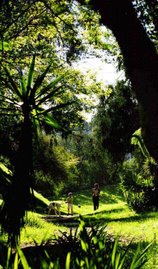Photo: Andrew Sears, October 10, 2012. One of the 2 larger oak trees cut down last week, with Sears' size 12 foot for scale. (Click on photos to enlarge.)
We received email from one reader suggesting the oak trees cut down on the vacant lots on Glendale Blvd & Bancroft were not native Coast Live Oak, but might be non-native Cork Oak. The bark is unusual in that it's spongy and cork-like.
So, we checked CalFlora for oak trees in Los Angeles County. Looking through the linked photos, it raised further questions. I asked Sears to shoot some more photos before the lots were completely cleared of tree debris.
We apologize for the initial misidentification. However, when it comes to the potential loss of significantly sized trees, native or non-native, it was better to sound the alarm before the evidence disappeared.
Photo: Andrew Sears, October 10, 2012. Sears also collected some leaves, acorns, bark and a slice of a branch for further study. Those are 1" squares on the mat.
We ran these photos and a few others past a local professional landscape designer, a Los Angeles Community Forestry Advisory Committee (CFAC) boardmember, in addition to a neighbor who had a Cork Oak Tree in her yard when she lived in San Diego. They all agree it might be Cork Oak, a non-native species. All 3 agree it is not an easy ID and they believe it is not Coast Live Oak. There are several Cork Oak Trees in the 3900 block of San Rafael in Mt Washington.
Photo: Andrew Sears, October 10, 2012. While these trees are not our native protected Coast Live Oak, at least 2 were huge and sprawling, large enough to be considered "significant" trees - trees of more than 8" diameter. There were also 2 smaller approximately 6" diameter oak trees cut down as well.
In City Planning parlance, a "significant" tree only merits replacement on a 1:1 basis with a tree that won't reach this size in our lifetime. Protected native trees require a higher replacement ratio, but unfortunately, the Protected Native Tree Ordinance doesn't really protect any native trees. City Planning just uses the replacement ratios and fails to evaluate the cumulative loss of mature native trees in our hillsides.
The fact that these trees were cut down prior to a development application being filed for these lots, indicates the developer didn't want to declare plans to remove those trees when they filed plans.
Mature trees add value to homes. They also reduce air conditioning costs by providing shade. Depending on the species, they help hold hillsides together in the rain. The largest of the felled oak trees has been holding the hillside from falling into Glendale Blvd, below, for decades.
Eucalyptus, palm trees and timber bamboo do not hold hillsides together, their root structure is not deep, they are extremely combustible and can be a liability for hillside homeowners.
I know at least one architect who goes out of her way to design homes around existing mature trees. The Silver Lake - Echo Park - Elysian Valley Community Plan discusses the significant urban forest existing in all 3 communities; calls for preservation of mature trees wherever possible. Neither the City, nor most developers share in our communities' urban forest values.





